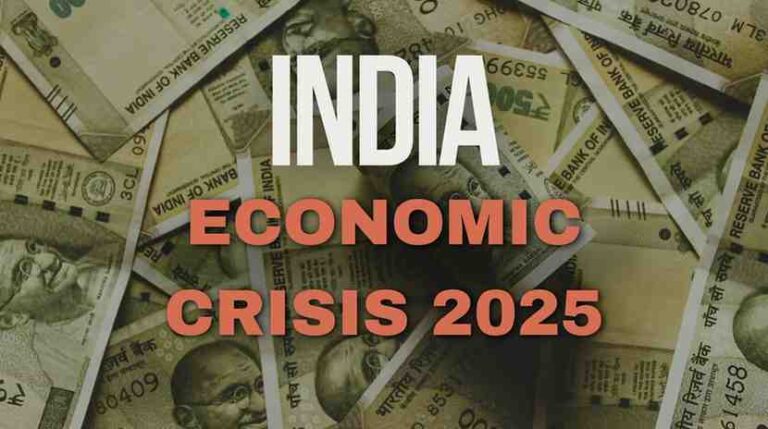India Economic Crisis 2025: A Tipping Point
The economy in India finds itself in a critical situation now in the first quarter of 2025, grappling with a worsening crisis that may derail its growth story. The triple whammy of inflation, unemployment, and rising inequality has choked domestic consumption and is now creating ripples across the globe. Inflation, extremely elevated over the past one year, has gyrated around 6.7% with high cost of living dating the middle class heavily, which used to form the backbone of the Indian economy.
Another dimension of this dilemma is unemployment itself, which has reached alarming levels as early as the beginning of the January 2024 statistics of an unemployment rate: 8.1%, particularly among the youth and educated ones. Well, this not only hampers consumer spending but also creates a dampening effect on both domestic and foreign investors. The vision of ‘Make in India’ has gone into shadows and has been replaced by the reality of jobless growth. Economic growth without progress in terms of job is just a dream.
On the contrary, the rich are getting richer, with the stock market giving them returns on their investments. Inflation, however, is telling against the middle class, who find that the little savings they have are being outrun by inflation. This economic divide stretches far beyond the borders of India, as the very consumption patterns here affect world commodities prices and trade patterns.
Inflation – A Persistent Economic Headache
Inflation in India in 2025 was sometimes making comforts uncomfortable for its citizens. Inflation, which stood at approximately 6.7% during fiscal year 2022-2023, seems to have lost its power to ease up, not helping in the cost of living. The price rise has been due to a mix of domestic policy blunders and external economic shocks.
Now, let’s say that the high-value denominations of currency got demonetized during the last few years and coupled with an ill-implemented Goods and Services Tax, it actually caused disruption in the marketplaces, especially in smaller businesses and in most economies where cash transactions took place. Inflationary global increases in commodity prices, much especially oil, haven’t aided matters with increased fuel, thus transportation, and inflated production costs overall.
The most real effects of inflation are then borne by the middle class and, above all, by the thin slice of disposable income that they have left in their hands. Food, housing, and education are now becoming increasingly unaffordable, which dissuades consumption up to a certain level. It is not only a local issue but has a ripple effect worldwide as India’s consumption, which is a great force propelling the war around the globe, turns lukewarm. This is how the Congress party has painted the picture in media, where stagnated wages are coupled with rising costs eventually choking off the economy all the more, should it not be given urgent attention.
Unemployment – The Silent Economic Killer

Unemployment in India has reached the highest levels ever – and the worst affected have been educated youth among the unemployed. The sheer number of graduates being churned out into the labor force each year has added to the making of this demographic time bomb. The economic vision of ‘Modinomics’ purported to growth and jobs but instead, left most empty pockets, thus giving rise to the term used by some economists – a ‘K-shaped’ recovery. Where the poor and middle-class cutbacks are evidence enough for the rich to get richer.
The unemployment rate in India has increasingly echoed the overall health of the economy, and the most recent figures say around 8.1% unemployment in April 2024. The glaring absence of any job creations, more significantly relating to the manufacturing sector where major transformations were supposed to take place as part of ‘Make in India’, has been conspicuous. This section by the informal sector was employing a vast majority of the skilled labor force and is now badly hit by domestic policy shifts and external economic shocks, leading to losses and underemployment.
This unemployment crisis is a malaise that affects not only the local realities but also the wider planetary context. India’s demographic dividend, with its youthful and large workforce, had always been regarded as favorable for corporations worldwide seeking such a skilled labor force. However, with rising unemployment, that demographic potential is not being exploited, leading to lesser consumer expenditure and affecting the global fronts that depend on India’s demand. Besides, the social consequences of pervasive unemployment could contribute to possible political instability, which itself can affect the confidence of investors worldwide.
Inequality – Widening the Gap

The economic crisis has further widened the gap of inequality in India. Wealth distribution has skewed so extremely that the top 1% now own even more than 40% of the wealth-a figure that is at a multi-decade high. Inequality, however, is more comprehensive than income. It’s about access to opportunities, education, and healthcare, with the middle class feeling the pressure from both ends.
Inequality in India has widened to levels unseen for a century, with the concentration of wealth at the top being starkly visible. The middle class, which used to be the spine of India’s economic narrative, finds itself squeezed between stagnant wages and rising costs. While certain sectors of the share market appear to be reviving, the bulk of these gains are concentrated among the wealthy, while the middle class is left with investments that are perilously risky or that yield unacceptably low returns significantly below the rate of inflation.
The economic policies, or lack of effective ones, have not redistributed the wealth or created opportunities for the less privileged Indian citizenry. Infrastructure projects drawn up by the government are good enough, but they have not trickled down to either job creation or skill development of the masses. The discrepancy is far and wide. It has repercussions on the global market for goods and services; it reduces the purchasing power of a significant portion of the world population; and, if not addressed, can create social unrest; and ultimately, it mars India’s image as a stable economy where one can invest.
Policy Failures or External Shocks – The Blame Game
Heated discussions have begun in 2025 concerning India’s causes for the economic crisis that saw two major views developing-the first view of it being caused largely by internal policy blunders, while the second view focuses more on external shocks. Adding to the complexity of this discourse are worldwide political shifts, such as Donald Trump’s second coming to the White House, continuous wars, and the Indian government’s policy engineering.
Donald Trump’s Impact on India’s Economy
Devastating effects mark the re-election of Donald Trump to office as the 47th President of the United States for the Indian economy. During the first term, he introduced retentions in tariffs on countries that he felt had unfair trade practices, including India. The current campaign rhetoric from his side suggests a much more manifested “America First” approach with promises of higher tariffs and very restrictive immigration policies. Such policies directly hit the two most significant India-based exporting sectors to the US – IT and pharma.
An impending hike on Indian tariff imports might decrease India’s foreign exchange earnings by a great margin and, further, weigh upon the already low rupee. Besides, it would disrupt the Indian IT industry as the majority of such companies rely on H-1B visas for sending skilled employees to the US, so it would eventually lead to massive layoffs in India itself, leading to worse unemployment rates in India. Furthermore, his economic policies would further result in shifting the patterns of global investment, with an opposite flow of much-needed capital from our country due to an increase in US manufacturing.
War Impact on Economic Stability
At the same time, the continued strife, especially the war in Ukraine, has by one wave affected the commodity prices all around the globe-from the oil that India imports heavily-with worsened supply chains and increased energy prices shot up inflation in India while making necessities expensive to businesses and consumers. This external shock only adds to the already difficult situation in the domestic economy where India is currently grappling with energy security, which further complicates its balance between payments and the ongoing currency crisis.
The war has, in a way, re-evaluated global trade routes and alliances in which India finds herself in the delicate balancing of her strategic interests, particularly vis-à-vis relations with Russia, a traditional defense partner. Economic sanctions and altered trade dynamics have certainly made India seek alternative energy sources at a comparatively higher cost, thus further burdening the economy.
Government Policies and Their Impact

Inlandly, the interrogation persists on the policy decision by the Indian government. The demonetization of high-value currency notes in 2016 left a long draw on the informal sector, which is a significant segment of the economy in India. The rollout of GST, which was envisaged to streamline taxation, confused small businesses at first, thereby giving rise to compliance issues. These policies were aimed at formalizing the economy but rather disrupted cash flows and made workers lose their jobs, contributing further to the current unemployment crisis.
Contemporary moves toward protectionism and an inward-looking economic policy have surely aimed at increasing local manufacturing, but job opportunities have not increased to the expected levels. Infrastructure has been a point of focus without commensurate job creation, and many are questioning the efficacy of such policies in the light of escalating unemployment and inequality.
The share market is mixed, with some sectors gaining from local consumption, while others face declines due to global demand fluctuations. However, the overall sentiment is one of caution; as a result, foreign investors have begun to exit, culminating in a currency crisis. In terms of the latest economic data, a fiscal deficit of 4.4 percent of GDP gives some leeway but requires underlining clarity in the economic management.
India Economic Crisis – Impact on the Middle Class and Beyond
The middle class, India’s most dynamic class in the economy, is now confronting unparalleled challenges. Savings are depleting, and the dream of climbing upwards looks so far and bleak. This economic woes of this class will result in lesser expenditure and, therefore, affect the economy of the nation and the globe. The volatility-up and down swings-of the share market has made the investment a precarious proposition for the middle class, most expressing concerns over the reduction in their wealth rather than its growth.
The ripple effect would be felt by the global economy in terms of reduced demand for goods and services, reduced investments by Indian corporates, and an investment pattern shift from India owing to the economic risk perception. Further, the business of India in global supply chains, be it in pharmaceuticals or IT services, could be put at risk in case of more closures or movement of businesses because of the economic crisis.
The economic crisis in India in 2025 has many dimensions centered around inflation, unemployment, and inequality that wrought tremendous damage upon the middle class, thus affecting the global economy. Whether the government is taking the right path in terms of policy has been questioned, but external shocks have indeed aggravated the situation. The possibility of India’s recovery will hinge on a balanced approach: homegrown policy reforms and resilience to shocks from the world economy. Otherwise, India’s hope of becoming an economic giant may remain limited to rhetoric, throwing its citizens, especially the middle class, into economic limbo.
It is not merely a tale of numbers; it is about the lives of the millions, the state of an economy in the global arena, and one brave nation’s future path among the most populous in the world.
This Article Researched = Business Standard AND BBC News




